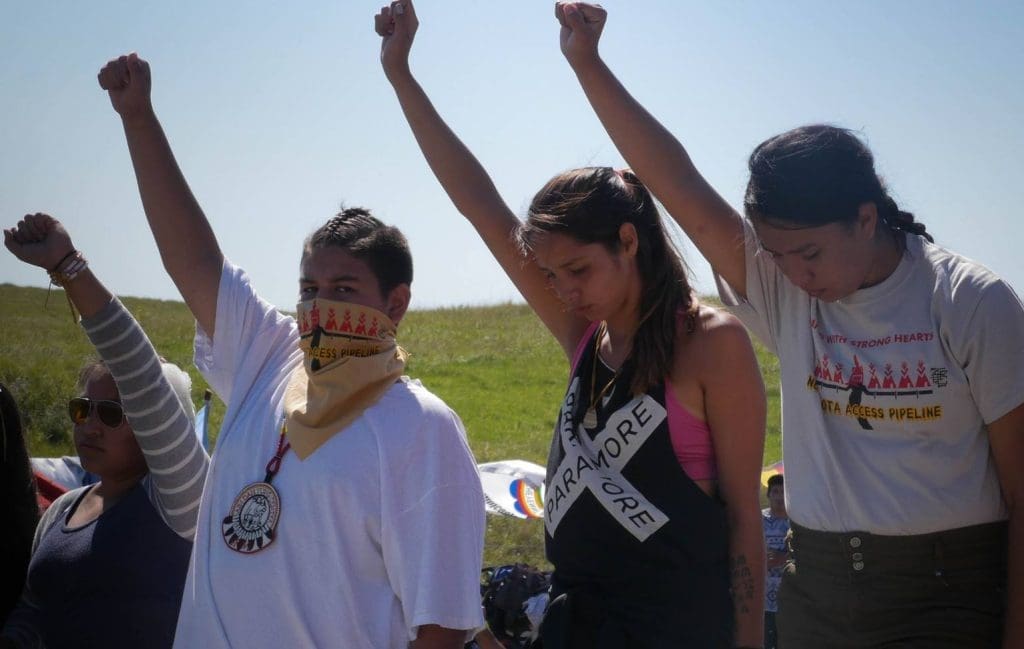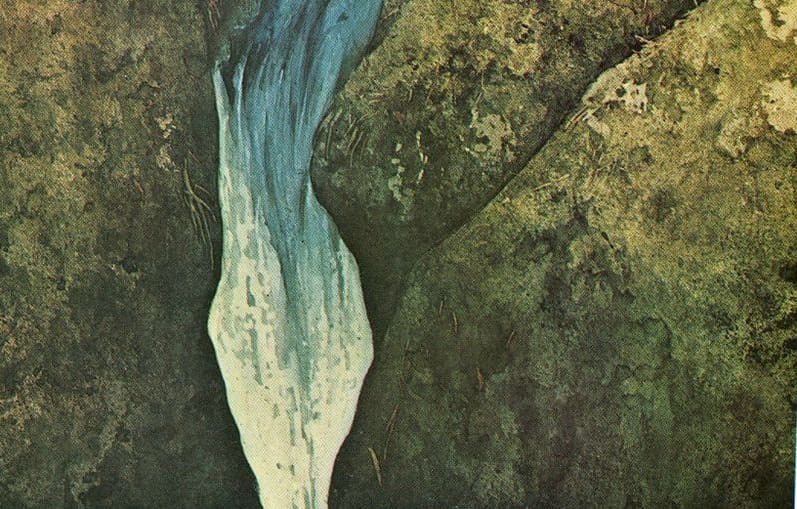Transcribed from the 24 September 2016 episode of This is Hell! Radio (Chicago) and printed with permission. Edited for space and readability. Listen to the whole interview:
These corporations see our lands as an easy target, because many of our nations are living in conditions of poverty. Maybe they think we’ll be less likely to speak up. But we know what is being threatened.
Chuck Mertz: An oil pipeline threatens historic Native American sites of great cultural significance—which is bad enough, but it also threatens the water supply. Here to tell us all about the protests that are taking place in the Dakotas, Dr. Sarah Jumping Eagle is a pediatrician and member of the Oglala Lakota and Mdewakanton Dakota nations. Thank you for being on the show, Sarah.
Sarah Jumping Eagle: Thank you for having me.
CM: I want to go back in time a little bit in pipeline protests. Protests against the Keystone XL pipeline date back to March 2012, when Debra White Plume, Alex White Plume, Sam Long Black Cat, Andrew Iron Shell and Terrell Eugene Iron Shell were arrested for creating a blockade in an attempt to stop two tarsands pipeline trucks from entering Pine Ridge Indian land in South Dakota. The trucks refused to turn around, claiming they had corporate rights that supersede any other law.
Was that the beginning of this current protest movement, four years ago? Are these two protests linked?
SJE: All of the threats on our water, our sacred sites, and on the land are connected. There has been a gradual increase in threats to our Native lands and in incidents of environmental genocide, and as we’re becoming aware of these threats we are working to protect our people and protect our right to water and to a healthy future.
They are linked in the way that these corporations see our lands as an easy target. They think that they can go near our land because many of our nations are living in conditions of poverty—maybe they think we’ll be less likely to speak up. But we know what is being threatened. We know that our future is being threatened, and we’re not willing to sacrifice that.
CM: As CNN reported in August, the Standing Rock Sioux tribe has sued the federal government, saying the Native American tribe was not properly consulted over the project to construct an 1,168-mile crude oil pipeline that extends over four states. While proponents of the Dakota Access pipeline tout its economic boost, opponents question its environmental impact.
Let’s talk about the good and bad of the pipeline as CNN framed it. How much of an economic boost would Native Americans experience from the crude oil pipeline?
SJE: I would say almost none. North Dakota is a huge proponent of the oil and fracking industry here in the state, but our specific communities would take all the risks and get almost none of the benefits.
The companies are subcontracting and using mostly out-of-state companies to come in, and they are utilizing man-camps that are mobile; they come in for a short period of time and move as the work progresses. And we already know from the Bakken in northwestern North Dakota that along with that comes all the other risks to the local communities: increased crime rates, increased trafficking of women, and other public health threats as well.
CM: Is there a racial divide, or is that too much of a generalization that I’m making? Is there a racial divide when it comes to supporting or opposing the Dakota Access pipeline?
SJE: Our support in the fight to protect water has been pretty broad-based. We’ve had numerous nations across this continent and internationally support this movement to protect the water, and they have been non-Native and Native alike. Mostly Native, but we have numerous non-Native allies as well. And people who are affected downstream in South Dakota, Iowa, and Illinois are fighting against this pipeline as well. They, too, are our allies. They are fighting for their land and water, and they are being arrested as well, and they’ve been fighting against this pipeline for a long time just as we have.
But locally, Native people make up about ten percent of the population in, say, Bismarck (which is the city about 65 miles north of us) and in North Dakota you do see some of those divides along racial lines, because non-Natives are the majority, and although they are downstream from another point, Lake Sakakawea, where this pipeline will be crossing, there’s a lot of denial about what the risks are. It is scary to think about. So the tendency is for people to want to listen to the governor and the public service commission telling them that everything’s going to be okay. But they’ve just been repeating the statements of the oil industry, which has huge propaganda/media control in the state.
CM: Let’s talk about those risks for a second. What is the potential for environmental damage to Native land from the pipeline, and what harm could that cause to Native Americans in the area when it comes to affecting the water supply?
SJE: The way the Dakota Access pipeline route is set up is to run just north of the town of Cannon Ball and just north of the reservation boundary. The town of Cannon Ball’s water intake is on this route that the pipeline would cross. There’s another bigger town on the reservation, Fort Yates, about twenty miles south of Cannon Ball (and there are scattered people living in the country as well) whose water intake could be affected.
There are eighteen million people that depend on the Missouri river for their water, and as you go downstream on the Missouri river, it would also affect the Ogallala aquifer. There’s also a huge water pipeline, the Mni Wiconi water pipeline, that runs off of the Missouri river and feeds into many communities in South Dakota, including the Cheyenne River reservation—which is another Lakota nation—and the Oglala Lakota nation, where I’m originally from. This water pipeline would be affected if there were a spill from the proposed Dakota Access pipeline.
CM: So what would happen if there were an accident and that water were poisoned by this pipeline? What is the potential impact on the population, whether Native or non-Native, from consuming that water, or using that water for bathing, or for farming?
SJE: In order for them to pump this crude oil through the pipeline, they have to add numerous chemicals. Crude oil contains hydrocarbons, including benzene, and other places that have spills, such as Kalamazoo, are still finding chemicals in the water right now.
Our communities have already been suffering the effects of the Bakken, with all the fracking along the Missouri river north of us, and also the flaring that’s been going on. We’ve already been going through that for the past ten years. That’s been minimally regulated, and that doesn’t even mention the radioactive fracking socks that have been dumped in numerous places throughout the state.
If there were a spill, you’d have to picture what happened in Kalamazoo, where they still have sludge in their river. They’re still finding chemicals in their river. The Missouri river is one of the last rivers that is relatively clean, and many people depend on it.
To me as a physician, I feel that we’re undergoing a huge public health experiment that is happening to my own children. We won’t know the full effects for another ten to twenty years. But we know that hydrocarbons can put people at risk for cancers and could effect their DNA. And there are other researchers who have looked at the chemicals that are added to crude oil and tarsands (ultimately, we think that this pipeline will be linked up with the tarsands as well, which would add even more chemicals), and have shown that those chemicals can affect neuro-endocrine receptors, which could affect reproductive health.
It’s a way of praying when people smoke the pipe. The smoke goes to the creator directly. When there’s talk at the protest site of the pipe, that’s what people are talking about. It just shows the ethnocentrism and ignorance of the sheriff’s department, who are all non-Native, that they interpret it to be pipe bombs.
CM: What are the historic, religious, and cultural significances of the area that would be affected by the pipeline? How important are those to the Native American community there?
SJE: There are numerous known prayer sites. But for a long time the United States made our spiritual ways illegal, so a lot of the knowledge about this had to be kept underground for a long time. People knew where the sites were. You can even see some from the roads: there are certain places where there are player flags up on top of the hills. Those are known sites where people would go to pray or offer tobacco or food to the spirits. There are other sites that are used for ceremonies, for example where people would do Hanbleceya, what is possibly known as vision quests.
But what wasn’t greatly known about were these stone sites, stone formations and graves. Once a cultural surveyor, Tim Mentz, was allowed by one of the landowners to go on this site, he documented numerous stone formations and grave sites. But when he submitted that information to the courts, it became public knowledge, and the company got a hold of it. They jumped twenty acres of land to go specifically to those sites and start bulldozing, and they destroyed several of those prayer and grave sites.
That resulted in the event where protectors went there to stop them, and they had armed security guards with canines who were not trained, and they were macing people. That was the event that Amy Goodman documented, and now has been charged with trespassing herself.
CM: In early September, as you were just saying, and as Sarah Sunshine Manning reported in Indian Country News, “On the afternoon of September 3rd a procession of prayerful water defenders, consisting of men, women, and children, walked on foot up to the original protest site where the first demonstrations took place in early August. Unbeknownst to them, Dakota Access construction workers were fast at work approximately a mile up the road bulldozing the earth, destroying graves and sacred sites while creating a path for pipe to be laid.”
Ursula Young Bear, Oglala Lakota from Porcupine, South Dakota, was quoted saying, “We were walking up to the flags on the highway to sing and pray. Then we found out they were starting to build again.” Dave Archambault II, Standing Rock Sioux tribal chairman, is also quoted saying, “This demolition is devastating. The grounds of the resting places of our ancestors, the ancient cairns and stone prayer rings cannot be replaced. In one day, our sacred land has been turned into hollow ground.”
How surprised were activists when this demolition began?
SJE: We were pretty surprised. They were constructing in other areas, we were aware of that, but they hadn’t been in that area for several weeks. And the tribe was pursuing justice through the courts; there was some reassurance that maybe there would be some decisions made that would assist in stopping the pipeline at least in that area. We knew that there wasn’t going to be complete control, because a lot of this was private land, but most people were still pretty surprised.
But I guess it fit in with how corporations have been treating Native people and farmers and ranchers. We know that they’ve been harassing farmers and ranchers and using a pretty strong arm to get their way. So it’s in line with their tactics and policy.
CM: Again according to Indian Country News, “Approximately eight dog handlers hired by Dakota Access led the barking and snarling dogs right up to the front line.” A gentleman by the name of Young Bear is quoted saying, “It felt like a setup.” The article continues: “The moment grew so intense that the dogs soon started to turn on their handlers. Dakota Access guards and dog handlers then left the scene.”
How would you describe the relationship between Native Americans and the local police? And aren’t there indigenous police that can at least enforce the rights of the indigenous?
SJE: Where a lot of the protest occurred is just north of the boundary of the reservation. The Cannon Ball river is one of the northern boundaries of the reservation; just north of that is Army Corps land, and then you get to private land: Cannonball Ranch on the east side, and another private piece of land on the west side. That’s where the sacred sites are and where the event with the bulldozers and the guard dogs occurred.
Morton County has jurisdiction over those areas of private land; south of the Cannon Ball river is where the BIA tribal police would have jurisdiction. So most of this is occurring in the jurisdiction of Morton County police. And they showed everyone from the get go that they were pretty strongly aligned with the security guards and the corporation. Some of their statements were taken directly from the security guards’ statements. In the first couple of days of the protest, August 11th and 12th, Morton County sheriff Kirchmeier made statements saying that they were concerned—and calling for an emergency declaration—because protesters possibly had weapons or pipe bombs.
There were no weapons. There haven’t been weapons at all. But we determined that we frequently talk about our pipe. Our pipe is the way that we pray. It’s our Chanunpa, our most sacred way. It would be similar, maybe, to the cross for Christians. It’s a very revered item and it’s only brought out on certain occasions, and people know, in our ways, to respect the pipe. When people talk about bringing out their pipe, people know that it is very serious, and that they need to pray. It’s a way of praying when people smoke the pipe. The smoke goes to the creator directly.
When there’s talk at the protest site of the pipe, that’s what people are talking about. It just shows the ethnocentrism and ignorance of the sheriff’s department, who are all non-Native, that they interpret it to be pipe bombs and then quickly made an emergency declaration to escalate the militarization of their police force.
From my perspective a lot of this is about money from the corporation, the county, and the state. As long as they perpetuate this idea that there is an emergency and there are threats and weapons, then they will continue to receive extra funds from the state. The governor of North Dakota has actually asked federal agencies for additional funds as well.
We’re fighting for our human and civil rights, for a healthy living environment; that should take priority over corporate needs. That does not fit with corporate sponsored media.
CM: A past guest on our show, Rebecca Solnit, wrote in the Guardian on September 12th, “In a joint statement by the US Army, the Department of Justice, and the Department of Interior (which oversees Native American affairs), two major decisions were announced. One was a decision by the US Army Corps of Engineers, the permitting body for the pipeline, to hold off on issuing permits to dig on federal land near or under the Missouri river above the Standing Rock reservation. The other was a landmark announcement that this fall the government would discuss with tribes how to better ensure meaningful tribal input into infrastructure-related reviews and decisions and the protection of tribal lands, resources, and treaty rights, and whether new legislation should be put in place to pursue those goals.”
So is the fight over a pipeline that could threaten the impoverished Standing Rock community now over? Did Native Americans win?
SJE: No. Because even now, in other areas, there is construction going on. People are still fighting and being arrested. The company has a huge financial investment, and so do many banks, and the state of North Dakota. And the company just bought the Cannonball Ranch, just two days ago.
So we know that their intention is not to stop. These other items are positive, but they haven’t changed the fact that the company is still actively pursuing this pipeline; the state of North Dakota is very invested in it; and we’re still going to be protecting the land and our water and our children’s future.
There are some areas where we don’t know exactly what is going to happen. But the three federal agencies basically told the company to do what they should have done in the first place, which was to do an environmental impact statement and abide by federal laws, including the National Historic Preservation Act, the National Grave Repatriation Act—to respect our very bones—and the Environmental Protection Act. By breaking this pipeline down into smaller pieces, they are trying to avoid these federal laws.
And the Army Corps will say that calling the tribes and not talking to anybody is an attempt at consultation. We’re talking about a nation, and a nation-to-nation consultation is not a phone call. Some in this state have been saying that the tribe has not participated, but our nation is not the same as one public individual. There were members of tribes who participated in the state’s public service commission hearings, but these hearings were held way up in the northwestern part of the state. They did not hold any in our area, but some people traveled there anyway. Either way, that’s not the same as a nation-to-nation consultation. That’s the part that people missed.
There are some positive things that have happened out of this, but it’s far from over.
CM: In Indian Country News, Jim Gray writes, “The mainstream media and federal and state governments must take this revolution seriously. These activists in North Dakota are speaking in a language that is larger than the Indian community itself. If their message is carried over the national news cycle in the same way that the protests in Eastern Bloc countries at the end of the Soviet Union were covered, or the Middle Eastern Spring just a few years ago, it would be easier to see why the pendulum needs to swing back to protecting our water against the pursuit of corporate interests, a message that resonates with people all over the world.”
Sarah, to you, what explains the media’s greater attention to revolutions and uprisings overseas, rather than those here in the US?
SJE: Basically it’s a corporate media. We see that with the elections; we see that with a lot of the news around the Black Lives Matter movement. We are also fighting against corporate interests, and all of this is connected. We’re fighting for our human and civil rights, for a healthy living environment; that should take priority over corporate needs. That does not fit with corporate sponsored media; many of them have been paid off by these very same corporations and banks.
The good part is that a lot of the younger generation, and my generation, know that the corporate media isn’t telling the truth, so we’re not even paying attention to them anymore. We’re shifting away to other types of media. They’re either going to have to get with it, or we’re just going to continue to ignore them and move on with the types of media that we use that are evolving and telling the truth.
CM: Sarah, thank you so much for being on our show. I truly appreciate this opportunity to talk to you.
SJE: Thanks for having me, I appreciate it. And thank you to the listeners, and thank you to everybody who is reaching out. It gives us hope to know that people care about the future, the water, and our children. When we’re fighting these struggles we know that there are people out there who are helping to make a difference and are standing up in their own communities as well.
Featured image source: Urban Native Era (Facebook)





